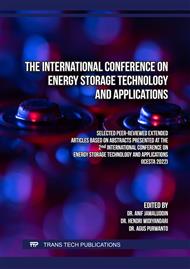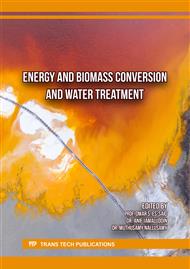[1]
G. Xu, P. Nie, H. Dou, B. Ding, L. Li, and X. Zhang, "Exploring metal organic frameworks for energy storage in batteries and supercapacitors," Mater. Today, vol. 20, no. 4, p.191–209, 2017.
DOI: 10.1016/j.mattod.2016.10.003
Google Scholar
[2]
K. Chayambuka, G. Mulder, D. L. Danilov, and P. H. L. Notten, "Sodium-Ion Battery Materials and Electrochemical Properties Reviewed," Adv. Energy Mater., vol. 8, no. 16, p.1–49, 2018.
DOI: 10.1002/aenm.201800079
Google Scholar
[3]
A. R. Nurohmah et al., "Sodium-ion battery from sea salt: a review," Mater. Renew. Sustain. Energy, vol. 11, no. 1, p.71–89, 2022.
DOI: 10.1007/s40243-022-00208-1
Google Scholar
[4]
M. D. Slater, D. Kim, E. Lee, and C. S. Johnson, "Sodium-ion batteries," Adv. Funct. Mater., vol. 23, no. 8, p.947–958, 2013.
DOI: 10.1002/adfm.201200691
Google Scholar
[5]
N. Yabuuchi, K. Kubota, M. Dahbi, and S. Komaba, "Research development on sodium-ion batteries," Chem. Rev., vol. 114, no. 23, p.11636–11682, 2014.
DOI: 10.1021/cr500192f
Google Scholar
[6]
P. R. Kumar et al., "Na 4 MnV ( PO 4 ) 3 -rGO as Advanced cathode for aqueous and non-aqueous sodium ion batteries," J. Power Sources, vol. 429, no. January, p.149–155, 2019.
DOI: 10.1016/j.jpowsour.2019.04.080
Google Scholar
[7]
M. Chen et al., "NASICON-type air-stable and all-climate cathode for sodium-ion batteries with low cost and high-power density," Nat. Commun., vol. 10, no. 1, p.1–11, 2019.
DOI: 10.1038/s41467-019-09170-5
Google Scholar
[8]
M. Sathiya, K. Hemalatha, K. Ramesha, J.-M. Tarascon, and A. S. Prakash, "Synthesis, Structure, and Electrochemical Properties of the Layered Sodium Insertion Cathode Material: NaNi1/3Mn1/3Co1/3O2," Chem. Mater., vol. 24, p.1846–1853, 2012.
DOI: 10.1021/cm300466b
Google Scholar
[9]
J. Y. Hwang, C. S. Yoon, I. Belharouak, and Y. K. Sun, "A comprehensive study of the role of transition metals in O3-type layered Na[NixCoyMnz]O2 (x = 1/3, 0.5, 0.6, and 0.8) cathodes for sodium-ion batteries," J. Mater. Chem. A, vol. 4, no. 46, p.17952–17959, 2016.
DOI: 10.1039/c6ta07392a
Google Scholar
[10]
P. Hou, J. Yin, X. Lu, J. Li, Y. Zhao, and X. Xu, "A stable layered P3/P2 and spinel intergrowth nanocomposite as a long-life and high-rate cathode for sodium-ion batteries," Nanoscale, vol. 10, no. 14, p.6671–6677, 2018.
DOI: 10.1039/c8nr00650d
Google Scholar
[11]
R. Mishra et al., "Surface modification of nano Na[Ni0.60Mn0.35Co0.05]O2 cathode material by dextran functionalized RGO via hydrothermal treatment for high performance sodium batteries," Appl. Surf. Sci., vol. 535, no. May 2020, p.147695, 2021.
DOI: 10.1016/j.apsusc.2020.147695
Google Scholar
[12]
N. Nitta, F. Wu, J. T. Lee, and G. Yushin, "Li-ion battery materials: Present and future," Mater. Today, vol. 18, no. 5, p.252–264, 2015.
DOI: 10.1016/j.mattod.2014.10.040
Google Scholar
[13]
A. Jumari, K. Nur, R. Stulasti, R. N. Halimah, L. A. Aini, and R. Mintarsih, "Production of LiNi0.6Mn0.2Co0.2.2O2 via fast oxalate precipitation for Li-ion," AIP Conf. Proc., vol. 030011, no. April, p.2–7, 2020.
DOI: 10.1063/5.0000646
Google Scholar
[14]
K. Kaliyappan, W. Xiao, K. R. Adair, T. K. Sham, and X. Sun, "Designing High-Performance Nanostructured P2-type Cathode Based on a Template-free Modified Pechini Method for Sodium-Ion Batteries," ACS Omega, vol. 3, no. 7, p.8309–8316, 2018.
DOI: 10.1021/acsomega.8b00204
Google Scholar
[15]
Y. S. Meng, G. Ceder, C. P. Grey, W. S. Yoon, and Y. Shao-Horn, "Understanding the crystal structure of layered LiNi 0.5Mn 0.5O 2 by electron diffraction and powder diffraction simulation," Electrochem. Solid-State Lett., vol. 7, no. 6, p.155–158, 2004.
DOI: 10.1149/1.1718211
Google Scholar
[16]
H. Yoshida et al., "P2-type Na2/3Ni1/3Mn2/3−xTixO2 as a new positive electrode for higher energy Na-ion batteries," Chem. Commun., vol. 50, no. 28, p.3677–3680, 2014.
DOI: 10.1039/c3cc49856e
Google Scholar
[17]
L. Xu et al., "Influence of precursor phase on the structure and electrochemical properties of Li(Ni0.6Mn0.2Co0.2)O2 cathode materials," Solid State Ionics, vol. 324, no. April, p.49–58, 2018.
DOI: 10.1016/j.ssi.2018.06.010
Google Scholar
[18]
D. H. Lee, J. Xu, and Y. S. Meng, "An advanced cathode for Na-ion batteries with high rate and excellent structural stability," Phys. Chem. Chem. Phys., vol. 15, no. 9, p.3304–3312, 2013.
DOI: 10.1039/c2cp44467d
Google Scholar
[19]
S. Kim, X. Ma, S. P. Ong, and G. Ceder, "A comparison of destabilization mechanisms of the layered Na xMO 2 and Li xMO 2 compounds upon alkali de-intercalation," Phys. Chem. Chem. Phys., vol. 14, no. 44, p.15571–15578, 2012.
DOI: 10.1039/c2cp43377j
Google Scholar
[20]
K. Park et al., "Characterization of a P2-type chelating-agent-assisted Na 2/3Fe1/2Mn1/2O2 cathode material for sodium-ion batteries," RSC Adv., vol. 4, no. 43, p.22798–22802, 2014.
DOI: 10.1039/c4ra01391c
Google Scholar
[21]
N. Yabuuchi and T. Ohzuku, "Novel lithium insertion material of LiCo1/3Ni1/3Mn1/3O2 for advanced lithium-ion batteries," J. Power Sources, vol. 119–121, p.171–174, 2003.
DOI: 10.1016/S0378-7753(03)00173-3
Google Scholar
[22]
J. In-Ho et al., "The effect of electrolyte on the electrochemical properties of Na/a-NaMnO2 batteries," Mater. Res. Bull., vol. 3, p.2–5, 2014.
DOI: 10.1016/j.materresbull.2014.02.024
Google Scholar
[23]
A. R. Nurohmah, K. Nur, R. Stulasti, W. G. Suci, K. Aliwarga, and A. Purwanto, "A Novel Synthesis of Cathode Material NaNi0.5Ti0.5O2 for Sodium-Ion Batteries," Key Eng. Mater., vol. 924, p.167–173, 2022.
DOI: 10.4028/p-563jm3
Google Scholar
[24]
H. Zhou, X. Zhao, C. Yin, and J. Li, "Regeneration of LiNi0.5Co0.2Mn0.3O2 cathode material from spent lithium-ion batteries," Electrochim. Acta, vol. 291, p.142–150, 2018.
DOI: 10.1016/j.electacta.2018.08.134
Google Scholar
[25]
N. R. Batti and N. R. Mandre, "Recovery and Characterization of Nickel Oxalate and Oxide Obtained from Spent Methanation Catalysts," Metall. Mater. Trans. B Process Metall. Mater. Process. Sci., vol. 51, no. 3, p.1225–1232, 2020.
DOI: 10.1007/s11663-020-01828-6
Google Scholar
[26]
K. K. Sahu, R. K. Sahoo, L. D. Beshra, and M. Mohapatra, "Facile synthesis of nickel oxalate@carbon as electrical double layer and its derived nickel oxide as pseudo-type supercapacitor electrodes," Ionics (Kiel)., vol. 27, no. 2, p.819–832, 2021.
DOI: 10.1007/s11581-020-03822-z
Google Scholar
[27]
A. Nadeina, P. Rozier, and V. Seznec, "Facile Synthesis of a Common Na-Ion Battery Cathode Material Na3V2(PO4)2F3 by Spark Plasma Sintering," Energy Technol., vol. 8, no. 5, p.3–7, 2020.
DOI: 10.1002/ente.201901304
Google Scholar
[28]
M. Frankenberger, M. Singh, A. Dinter, and K. H. Pettinger, "EIS study on the electrode-separator interface lamination," Batteries, vol. 5, no. 4, 2019.
DOI: 10.3390/batteries5040071
Google Scholar
[29]
R. Holze, "Impedance spectroscopy [ E . Barsoukov and J . R . Macdonald ( Eds .)]," p.651–653, 2008.
DOI: 10.1007/s10008-007-0260-1
Google Scholar
[30]
V. Dall'Asta et al., "Aqueous Processing of Na0.44MnO2 Cathode Material for the Development of Greener Na-Ion Batteries," ACS Appl. Mater. Interfaces, vol. 9, no. 40, p.34891–34899, 2017.
DOI: 10.1021/acsami.7b09464
Google Scholar
[31]
D. Buchholz et al., "Toward na-ion batteries - Synthesis and characterization of a novel high capacity na ion intercalation material," Chem. Mater., vol. 25, no. 2, p.142–148, 2013.
DOI: 10.1021/cm3029615
Google Scholar
[32]
K. Karthikeyan et al., "Electrochemical performance of cobalt free, Li 1.2(Mn 0.32Ni 0.32Fe 0.16)O 2 cathodes for lithium batteries," Electrochim. Acta, vol. 68, p.246–253, 2012.
DOI: 10.1016/j.electacta.2012.02.076
Google Scholar



